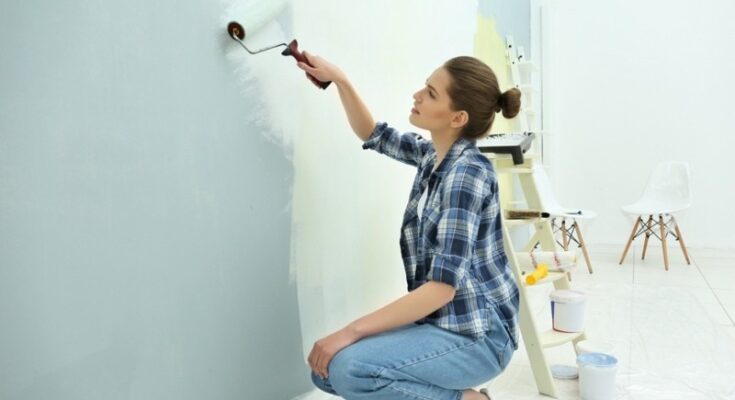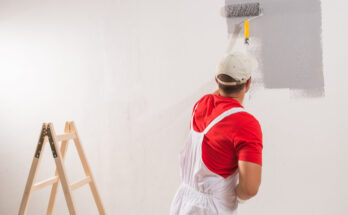A coat of paint makes your rooms look clean and give your home a touch of sophistication. It gives you a chance to redecorate your home, and for that, you don’t have to dig into your pocket. However, interior painting is challenging and stressful for most people because they often don’t get a flawless finish. It happens when you do not follow the proper techniques or use the right tools.
Therefore, to minimize the stress and make the task easier, you should hire a company that offer the best painting in Australia. Such companies have a team of experts who have in-depth knowledge about interior painting, so you get the best possible result.
They focus on all vital aspects of painting and thus carry out the process in a flawless manner. However, if you want to get the job done by following DIY ways, you need to follow some guidelines.
Here are eight interior painting tips for a flawless finish.
1. Clean the Surface with a Tack Cloth
A tack cloth is a useful painting tool that is used to clean a surface before painting to get the best result. It can be used to get rid of sawdust, wood shavings, and other debris off the surface. You can avoid using a wet cloth on the surface by using a tack cloth.
You can use a damp cloth instead of a tack cloth if you don’t have one, but make sure that you wring it out fully first. Tack cloths should not be used on huge surfaces. It works best for trim, doors, and cabinets rather than walls and ceilings. It is one of the best ways to properly prepare walls for painting.
2. Invest in High-Quality Tools
Roller covers that are made of bad quality material, leaves fuzz and lint on the walls. When such things are present in the paint and the paint gets dry, you are left with rough walls that are not easy to repair.
Therefore, it is advisable to invest in high-quality brushes and not carry out interior painting using cheap brushes. If you hire a company that offers professional painting services in Australia, you will see that the experts always use a premium quality brush.
3. Use High-Quality Paint
When painting a room, oil paint produces the best effects. Oil paints are more durable than water-based paints and will withstand more wear and tear in your home. Such paints are also more versatile than water-based paints as they can withstand stains better. If you decide to use water-based paint, make sure to apply three to four coats.
4. Apply the Painter’s Tape Appropriately
You will avoid future headaches by putting in the work with your painter’s tape. You can apply in advance to establish a tight seal with a putty knife across the tape to prevent drips. To avoid harming your hard work, remove the tape before the paint fully dries. When painting, it’s also a good idea to keep a moist cloth handy, so you can easily clean away any spills or drips.
5. Do not forget to Use a Primer
People, who use DIY techniques, often skip the priming and go directly to painting, but experts beg to differ. They believe that primer help in the creation of a consistent base, the concealment of flaws, and gives you a flawless finish.
So it is necessary to apply primer before painting. One coat of high-quality primer will be enough for most surfaces. If you are painting over a bright color or a rough surface, you may need to let the first coat dry before going over it again.
6. Cover Clean Areas Using Masking Film
Masking film is one of those hidden techniques that certified painters in Australia use all the time, but many DIY painters are unaware of. Masking film is a thin plastic sheet that comes in rolls or squares that can be folded up. Its thinness is crucial to its success.
Masking film, unlike the thicker plastic sheets that commonly used to cover furniture, latches onto flat surfaces and stays put on its own. There is no need to tape the film down unless you bring it up to the edge of a painted surface.
7. Allow the First Coat to Get Dry Completely
When painting your walls, you can’t apply multiple layers at once. Wait until the first coat is entirely dry before applying the second coat for the best results, which can vary based on your environment and painting procedures.
According to experts, the suggested time between the wall and trim paint applications is two to four hours, and the recommended time for ceiling paint and primer is one to two hours. However, if you are painting in cold or high humidity or temperatures can take longer to dry and recoat.
8. Paint Around Trim Carefully
It’s difficult to paint around baseboards and other trim in a room. If you are painting directly onto drywall, make a pencil note on the wall where the baseboard is so you don’t miss it when you’re painting. Paint has a tendency to leak beneath the baseboards, resulting in cracks and flaking paint over time. Apply caulking around the baseboards before painting them to avoid the issue.
The Bottom Line
Interior painting is not as difficult as it seems. All you need to do is, follow the tips mentioned above, and you will get the desired result.
To avoid the stress and hassles of painting, contact professionals who offer reliable painting in Australia. Whether you want to paint your home at the time of moving in, during your stay or when moving out of home, hiring professionals is always beneficial.

